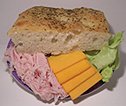For some, cooking is a form of both physical and spiritual nourishment. In a time when it becomes more and more difficult to find a young person with the desire to cook, Ashton Deakin, 24 years old, has a passion for baking bread. "To me, baking bread is an art form, and a great loaf of bread is just a beautiful thing," Deakin says.
Deakin, bread guru and enthusiast since he was 16, leads us through the process of perfecting the art of foccacia bread. The two-day process is a regular routine for Deakin, who has baked bread at Rainbow Whole Foods for about five months.
Ingredients
1 3/4 cup water at 78 degrees
1 teaspoon dry yeast
3 cups organic white flour
1/4 cup whole wheat flour
1/4 cup olive oil
2 teaspoons salt
olive oil and oregano for the top
Day 1: Prepping the Dough
Step 1: Put it all together
"Take the water and the yeast and let them sit for about five to six minutes until the yeast dissolves in the water. Then add your whole wheat flour, your white flour, then your olive oil and your salt."
Step 2: Mix it up and watch your dough
"Mix the ingredients for 10 to 12 minutes. With foccacia, it's not going to form a real tight dough. You want it to be real loose and wet, and it's going to stick to the sides of your bowl until the end of that 12 minutes. In this step you're just trying to create the gluten strands to hold the bread together."
Step 3: Give it a rest and be patient
"Take your dough and make sure it's in a bowl you can cover. Cover the bowl and put it in the fridge for eight to 24 hours."
Day 2: Let there be bread
Step 1: Give it some room to breathe
"Take the bowl out of the fridge and let the dough rise to room temperature or a little bit below. Divide the dough into a ball of about one pound and let it sit for five minutes. Preheat the oven to anywhere between 350 to 375 depending on your oven."
Step 2: Roll your dough
"Roll the dough out like a pizza crust into a nice circle. Let it poof up so it doubles in volume."
Step 3: Treat your dough to a massage
"Splash some olive oil on top of the bread and spread it around with your hand until the whole loaf is completely covered. Then sprinkle it with a little salt and oregano."
Step 4: When push comes to shove
"You kind of want to push against the dough, and if it springs back just a little bit, it's perfect. But if it springs back too much, and it's really elastic, it's way too early to put it in the oven. If you push it in and it doesn't spring back at all, then it's over—you might as well throw it away.
"Once you do put it in the oven, you're just looking for a nice golden color on the bread, and then it's good to come out of the oven."
Previous Comments
- ID
- 84458
- Comment
Generally speaking, what's the best oven temperature for baking bread...? My gut tells me 325, but I don't really have any idea. Cheers, TH
- Author
- Tom Head
- Date
- 2006-02-03T10:29:18-06:00
- ID
- 84459
- Comment
Tom, don't let Frank catch you! Hasn't he banned that? Or was it just public foccaciating?
- Author
- Rex
- Date
- 2006-02-03T11:31:48-06:00
- ID
- 84460
- Comment
Oh, my. :P
- Author
- Tom Head
- Date
- 2006-02-04T05:16:02-06:00



Comments
Use the comment form below to begin a discussion about this content.
comments powered by Disqus